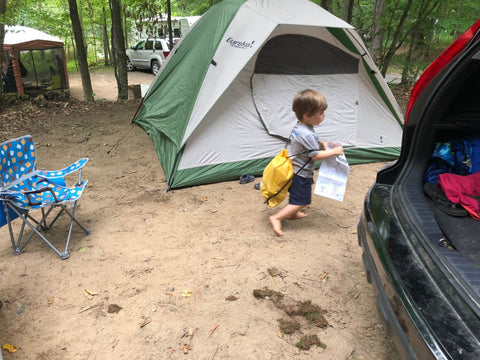
Finding the Best Campsite for Your Family
With warmer weather finally here (or almost here), many are looking forward to enjoying some fresh air and nights under the stars with their families. Some of my best childhood memories involve piling into the car with my siblings and parents and setting up camp in the woods or near a lake. I also vividly remember (fondly) the misadventures and hilarious mishaps that ensued when my parents forgot the tent poles or chose our campsites poorly. Thankfully, it’s now far easier to research available campsites and choose what works best for our family camping adventures.
When searching for the perfect spot to camp, the first thing to consider is the specific preferences of your family. It’s not enough to choose a spot that your sociable neighbors rave about if your family happens to prefer a quieter experience. On the flip side, if your kiddos prefer to be around other kids and have plenty of activities to choose from, camping in the backcountry may not be their favorite option. In this post, we will break down three of the main types of camping sites along with some things to consider when choosing a spot to set up camp.

Types of Camping Spots
Before you can decide where to go, you need to first decide what type of camping you plan to do. Do you prefer a popular campground with tons of extras? Or maybe a spot in the backcountry with a wide-open, unobstructed view of the night sky? Whatever your preferences may be, here are three popular types of camping spots along with some resources for finding availability.
Established Campgrounds
This is the most popular camping choice when kids are involved. Established campgrounds tend to offer more amenities than other options including bathroom facilities, running water, picnic tables, fire pits, etc. In most cases, you simply make a reservation for a designated campsite, check in with the hike host upon arrival, and you’re set. This can take the guesswork out of deciding where to pitch your tent, and many campgrounds offer extra amenities or recreational options with families in mind (such as snack shops, mini-golf, and playgrounds).
One of the downsides to camping in established campgrounds is the close proximity to other campers, which can be tough at night if you pick a site near the all-night partiers. Also, there tends to be more light and sound pollution at campgrounds, making it tough to stargaze or enjoy the sounds of nature during your stay.
There are numerous apps and websites you can use to find reviews and availability for established campgrounds. Reserve America is the largest online system to find campground availability at most state and local government parklands. If you’re looking for a campsite on federal land, you’ll want to check out Recreation.gov, which is the primary booking platform for national parks.
Campendium is another great option to find more specific information from people who have visited a campground and ask questions you may not find answers to elsewhere. The Dyrt website and app also offer user reviews and suggestions for campgrounds and the pro version of their app allows you to search for free camping sites while offline.

Dispersed Camping
On the flip side, dispersed camping (camping outside of a designated campground) is a great option if you’re looking for a quieter experience and don’t mind the lack of amenities. This type of camping is generally free and doesn’t require a reservation.
However, that doesn’t mean you can just go out into the wilderness and camp wherever you want. While many public land areas (like BLM and National Forest Land) allow dispersed camping, you’ll still want to call ahead to a ranger station to check on local regulations and restrictions (especially fire restrictions). Some may even require a permit or registration at the trailhead to legally camp on their land.
You can search for dispersed camping spots with the USFS and BLM Campgrounds App or websites such as The Dyrt and boondocking.org.

Photo Credit: Anthony Johnson
Backcountry Camping
If you’re looking for an adventure that is off-the-grid and close to nature, backcountry camping may be the right fit for your family. Typically, backcountry sites are well away from roads and developed areas and require you to hike, bike, kayak, ride a horse, etc. to get there. You will need to carry everything with you (think backpacking, bikepacking, canoe camping, etc.) without the luxury of a car for hauling gear. However, you can’t get much closer to nature than camping this way!
Camping in the backcountry usually requires a permit, so you'll need to check the requirements at your desired location well in advance. Park rangers can provide some wonderful input on great spots to set up camp along your journey, so be sure to ask around before you head out.

Photo Credit: Jasmine Joleen
Things to Consider When Choosing Your Site
While you’re browsing the available options for your preferred type of camping, here are a few things to keep in mind when choosing a campground and campsite:
Distance From Home
When just starting out or with very young children, you may want to stay closer to home (within an hour or two if possible). This allows you to easily bail out and head home if things don’t go as planned (like if your child won’t sleep or a sudden downpour occurs).
Access to Essentials
Know where the nearest gas station and grocery/convenience store are to your camping spot. While this may not be as important for seasoned campers, it’s nice to have access to these essentials when you’re just starting out. I remember having to send my husband out for diapers and hot dogs after realizing that I forget them on our very first camping trip with our oldest. Thankfully we were close to a grocery store, so it didn’t take him long to grab what we needed.
Recreational Options
While dispersed and backcountry camping generally provide recreation right outside your tent flap, even established campgrounds can offer recreational options either onsite or relatively nearby. The first few times we camped with our oldest, we made sure the campgrounds we chose offered beach access to lakes along with hiking trails within walking distance. This helped to ease our kiddo into the camping experience without the need to constantly get in and out of his car seat.
If you have a destination in mind that doesn’t have availability onsite (such as a National or State Park or historic landmark), finding a campground or dispersed camping spot nearby increases your adventure and exploration time in those places by cutting down on travel time.

Proximity to Desired Amenities
You can find campgrounds that are equivalent to rugged versions of all-inclusive resorts, with everything from mini-golf, swimming pools, snack shops, and even free WiFi. Having access to a bathroom and potable water can be super convenient with young kids in tow, especially if they happen to still be in diapers (diaper blowouts are no fun without access to running water!). This is also a great option if you have very sociable kids who like to make friends with fellow campers.
On the flip side, you can also find displaced and backcountry camping spots with no amenities, yet a perfect view of the night sky with very low light pollution. These spots are ideal if you want to get away from the constant noise and bustle of civilization and enjoy the quiet sounds of nature.
Traffic
At popular campgrounds, traffic can be a little heavy at times (particularly on weekends and holidays). Choosing a campsite that is further from intersections within the campground can help keep your family safe and make for a quieter atmosphere. This is especially important if you have young children who like to wander or fast crawlers who happen to be part-ninja with their stealth tactics.
Closeness to Fellow Campers
The majority of families camping with young children prefer to find campsites further away from neighboring campers when possible. This helps lower the likelihood that noisy neighbors who celebrate into the wee hours of the morning will disturb your kiddos. On the flip side, it also prevents a cranky baby or child from keeping neighboring campers awake if they get fussy after dark.
If you have to be close to other campers, you can introduce yourself and make small talk with your neighbors. I have found that in many cases, campers are more understanding and less likely to be excessively rowdy if they know there are little ones nearby.

Where Will Your Next Family Camping Adventure Take You?
With so many options out there, it’s time to get planning! Do you have a camping bucket list? Do you already have your camping season planned? Let us know in the comments below!
Cover Photo Credit: Elise Giordano

Rebecca is a transplant Coloradoan living in Virginia with her husband (Derek) and their two boys. She’s a teacher turned freelance writer/ homeschool mom working towards exploring as much of the east coast as possible before the next move takes her family elsewhere. You can follow her family hiking, kayaking, SUPing, geocaching, camping, and all things outdoor adventuring on Instagram @frazzlednaturemom .


























